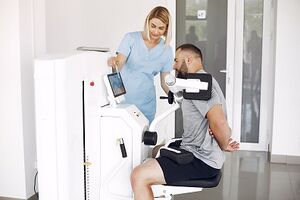Isokinetic Exercise
Introduction[edit | edit source]
Isokinetic exercise or accommodating variable-resistance exercise, is a type of therapeutic exercise which refers to force exertion against the isokinetic machine that leads to limb movement at a fixed velocity. [1] In other words, it corresponds to exercises whose limb velocity remain stable throughout the range of motion, and thus, muscle force and resistance in the machine are changing to meet this requirement. [2]
Isokinetic training is widely applied to rehabilitation in sport and rehabilitation; [3] however, there are also reports favouring the use isokinetic exercise in patients with neuromuscular diseases (NMDs). [4][5]
Types of Isokinetic Exercise[edit | edit source]
Isokinetic exercises may be concentric-concentric, concentric-eccentric, or eccentric-eccentric (dynamic muscle patterns).[2]
Advantages of Isokinetic Training[edit | edit source]
Reported advantages of isokinetic training include optimal muscle loading through accommodating resistance, exercise safety, and ability to undertake an objective muscle force analysis. [3]
Isokinetic Assessment[edit | edit source]
Apart from providing optimal and safe loading of the muscle in training, isokinetic machines can also be used in movement assessment and assessment of muscle strength to obtain objective, quantitative measurements and documentation of progress in rehabilitation.[1][6] Muscle strength can also be evaluated across differing speeds, and ranges of motion making this a useful tool for comparing the left to right side.
Control of speed in movement assessment may provide valuable insights on individual dynamic muscle patterns while providing stability to the testing positions (i.e. isolated action). [7] However, it must be noted that full control of speed in isokinesis is not possible since there are periods of acceleration, oscillation and deceleration throughout the range of movement. [3] Muscle strength is assessed by providing resistance by an isokinetic dynamometer throughout the range of motion at a constant velocity. This generates an isokinetic torque curve, whose highest point should normally indicate strength of a muscle or muscle group of the targeted joint.
Peak torque has been the most widely studied and recommended isokinetic strength testing parameter for research and clinical purposes. [6] However, impact artifacts on torque records depend on the dynamometer's compliance as it adjusts the moving limb to the present speed. [3] Since the speed of motion impacts the position at which peak torque occurs in a joint range, both analysis of maximal values at specific joint angles and peak values generated throughout a joint range across speeds should be made. [3]
Assessment of isokinetic eccentric movement can be performed either by (1) setting up a predetermined load and having the lever arm drive the extremity at the predetermined velocity, or (2) working against a passively moving lever arm at the predetermined velocity. [7]
A prerequisite of high reliability of isokinetic testing is to follow a testing protocol and provide adequate education to assessors. [6] In addition, although the reliability of some isokinetic dynamometers seems to be quite high when test-retest analyses are performed with inert weights, it is also suggested that submaximal warm-ups should be added prior to maximal testing to reduce the effects of muscle strain and neural inhibition on generated force.[3]
Disadvantages of Isokinetic Training[edit | edit source]
Collected data is in a machine-specific format and different data handling software programmes are used for different machines. [7] Thus, users need to be familiar with this type of data analysis and interpretation. [6] Another disadvantage of isokinetic devices is that this type of movement does not reflect actual human performance tasks and since it is quite (although not completely) specific to that type of movement, it does not transfer to functional patterns of performance. [6] Last, involving normally isolated joint training, isokinetic exercises can potentially produce large loads on the involved joints and may, therefore, under certain conditions be dangerous for healing tissues. [6]
References[edit | edit source]
- ↑ 1.0 1.1 Baltzopoulos V, Brodie DA. Isokinetic dynamometry. Applications and limitations. Sports Med. 1989 Aug;8(2):101-16.
- ↑ 2.0 2.1 Dale B. Principles of rehabilitation. In: Andrews J, Harrelson G, Wilk K. (eds) Physical Rehabilitation of the Injured Athlete. 4th ed. 2012, 41-66. Available from: https://www.sciencedirect.com/science/article/abs/pii/B9781437724110000046 [accessed 8/7/2023]
- ↑ 3.0 3.1 3.2 3.3 3.4 3.5 Osternig LR. Isokinetic dynamometry: implications for muscle testing and rehabilitation. Exerc Sport Sci Rev. 1986;14:45-80.
- ↑ El Mhandi L, Bethoux F. Isokinetic testing in patients with neuromuscular diseases: a focused review. Am J Phys Med Rehabil. 2013 Feb;92(2):163-78.
- ↑ Merlini L, Dell'Accio D, Holzl A, Granata C. Isokinetic muscle testing (IMT) in neuromuscular diseases. Preliminary report. Neuromuscular Disorders. 1992 Jan 1;2(3):201-7. [1]
- ↑ 6.0 6.1 6.2 6.3 6.4 6.5 Kannus P. Isokinetic evaluation of muscular performance: implications for muscle testing and rehabilitation. Int J Sports Med. 1994 Jan;15 Suppl 1:S11-8.
- ↑ 7.0 7.1 7.2 Wilk K, Reinold M, Andrew J. The Athlete's Shoulder. 2nd ed. 2009. Available from: https://www.sciencedirect.com/book/9780443067013/the-athletes-shoulder [accessed 8/7/2023]







